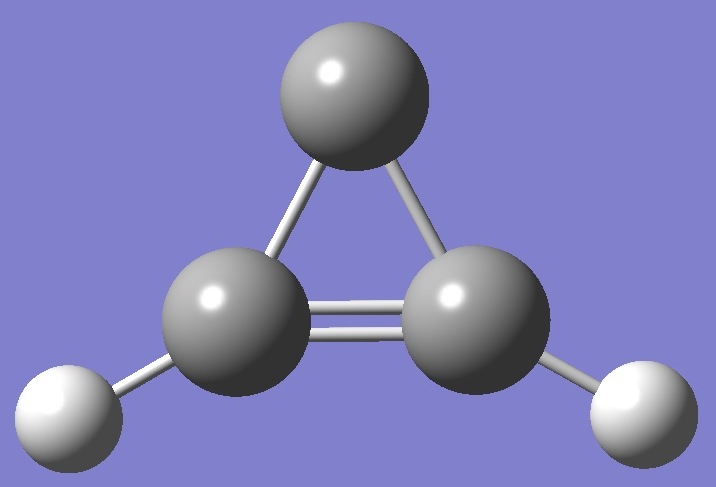|
|
|
|
|
|
|
|
|
|
|
|
|
|
|
|
|
|
|
|
|
C3H2 |
|
|

|
|
|
|
|
|
|
|
|
|
|
|
|
|
|
|
|
|
|
|
|
|
|
|
|
|
|
|
|
|
|
|
|
|
|
Deuterium |
|
|
|
Nuclear
Quadrupole Coupling Constants |
|
|
|
in Cyclopropenylidene-d1 |
|
|
|
|
|
|
|
|
|
|
|
|
|
|
|
|
|
|
|
|
|
|
|
|
|
|
|
|
|
|
|
|
|
Calcuation was made of the deuterium nqcc's in cyclopropenylidene-d1
on a structure given by MP2/aug-cc-pVTZ(G03) optimization. These
are compared with the experimental values of Bell et al. [1] in Table
1. Structure parameters are given in Table 2, rotational
constants in Table 3.
|
|
|
|
|
|
|
|
|
|
|
|
|
In Table 1, the subscripts a,b,c refer to
the principal axes of the inertia tensor, the subscripts x,y,z to the principal
axes of the nqcc tensor. The nqcc y-axis is chosen coincident with
the inertia c-axis. Ø
(degrees) is the angle between its subscripted parameters. ETA = (Xxx
- Xyy)/Xzz. |
|
|
RMS is the root mean square
difference betwenn calculated and experimental diagonal nqcc's.
RSD is the residual standard deviation of calibration of the
B3LYP/6-31G(df,3p) model for calculation of the nqcc's, which may be
taken as an estimate of the uncertainty in the calculated nqcc's. |
|
|
|
|
|
|
|
|
|
|
|
|
|
|
|
|
|
|
|
|
|
|
| |
|
|
|
|
|
|
|
|
Table 1. Deuterium nqcc's
in cyclopropenylidene-d1 (kHz). Calculation was made on the structure given by MP2/aug-cc-pVTZ(G03) optimization. |
|
| |
|
|
|
|
|
|
|
|
|
|
|
Calc. |
|
Expt. [1] |
|
| |
|
|
|
|
|
|
|
|
2H |
Xaa |
|
188.6 |
|
180.9(13) |
|
|
|
Xbb |
|
- 99.7 |
|
- 93.4 |
|
|
|
Xcc |
|
- 88.9 |
|
- 87.5(18) |
|
|
|
|Xab| |
|
45.6 |
|
|
|
|
|
|
|
|
|
|
|
|
|
RMS |
|
5.8 (4.8 %) |
|
|
|
|
|
RSD |
|
1.1 (0.9 %) |
|
|
|
|
|
|
|
|
|
|
|
|
|
Xxx |
- |
106.7 |
|
|
|
|
|
Xyy |
|
- 88.9 |
|
|
|
|
|
Xzz |
|
195.6 |
|
|
|
|
|
ETA |
- |
0.091 |
|
|
|
|
|
Øz,b |
|
8.78 |
|
|
|
|
|
Øb,CD |
|
8.78 |
|
|
|
|
|
Øz,CD |
|
0.00 |
|
|
|
|
|
|
|
|
|
|
|
|
|
|
|
|
|
|
|
|
|
|
|
|
|
|
|
|
|
|
|
|
|
|
| |
|
|
|
| Table 2. Cyclopropenylidene. MP2/aug-cc-pVTZ(G03) ropt molecular structure parameters (Å
and degrees). |
| |
|
|
|
| Point Group: C2V |
|
|
|
| Click on image to enlarge. |
|
|
|
 |
|
C(1)C(2,3) |
1.4210 |
|
C(2)C(3) |
1.3307 |
|
C(3)C(1)C(2) |
55.84 |
|
C(2)H(4) |
1.0759 |
|
C(3)C(2)H(4) |
150.12 |
|
|
|
|
|
| |
|
|
|
|
|
|
|
|
|
|
|
|
|
|
|
|
|
|
|
|
|
|
|
|
| Table 2. Cyclopropenylidene. Rotational Constants (MHz). Normal Species. |
|
|
|
|
|
|
ropt |
Expt. |
|
|
|
|
|
A |
35 211.9 |
|
|
B |
32 041.0 |
|
|
C |
16 775.9 |
|
|
|
|
|
|
|
|
|
|
[1] M.B.Bell, J.K.G.Watson, P.A.Feldman, H.E.Matthews, S.C.Madden, and W.M.Irvive, Chem.Phys.Lett. 136,588(1987). |
|
|
|
|
|
|
|
|
|
|
|
|
|
|
|
|
|
|
|
|
|
|
|
|
|
|
|
|
|
|
|
|
Table of Contents |
|
|
|
|
|
Molecules/Deuterium |
|
|
|
|
|
|
|
|
|
|
|
|
|
|
|
|
|
|
|
|
|
|
|
|
|
|
|
|
|
|
cyc_C3H2.html |
|
|
|
|
|
|
Last
Modified 2 March 2008 |
|
|
|
|
|
|
|
|
|
|

